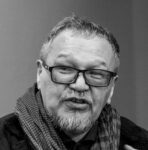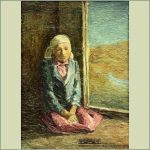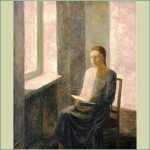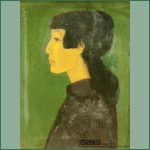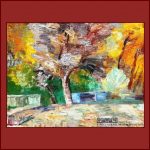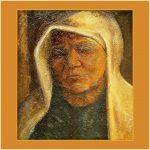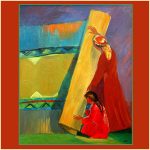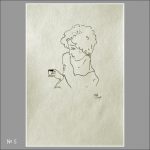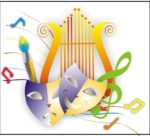
This is the second part of the two devoted to the work of Aitiev Satar as part of a review of the works of artists of Kyrgyzstan from the collection of our national museum through the eyes of art critic GAMAL BOKONBAYEV.
Satar Aitiev (1945) is a painter. Honored Artist of the Kyrgyz Republic. Born in the family of Gapar Aitiev, a famous artist. The State museum bears his name. Satar Aitiev got education as a film artist (VGIK – 1969). Works mainly in easel painting, in the genres of portrait, thematic composition, landscape, still life. He is also the author of a monumental work – the mosaic “Enlightenment” on the facade of the building of the Faculty of Chemistry of the KNU named after J. Balasagyn. Participated in exhibitions since 1968.
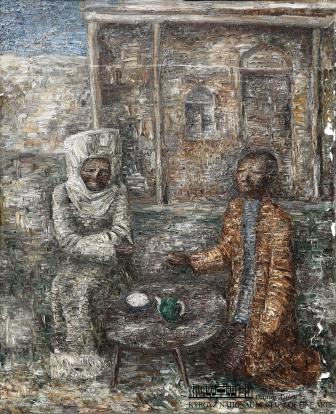 Aitiev Satar. My father. Canvas, oil. 110×90, 1975
Aitiev Satar. My father. Canvas, oil. 110×90, 1975
The well-known art historian Olga Popova writes about this work as follows: “In the painting “My Father” …, which reflects the theme of the Great Patriotic War, the plot and content aspect is also conveyed purely associatively: an orphaned mother and son sit at a low round table, each experiencing bitterness of loss in their own way. The mood of sadness is created by the images of an old woman in an elechek, a boy and, which is very important for Satar Aitiev’s work, the nature of the pictorial and coloristic decision”…. How easy it was for art historians in the USSR! At the same time how difficult. Remarkable Soviet art historians had to obey the template. It was impossible to deviate from the line approved from above, free associations with real characters and real events were not considered… The artist’s father, Gapar Aitiev (1912-1984), was the first professional Kyrgyz painter; Hero of Socialist Labor (1982); People’s Artist of the USSR (1971); Laureate of the State Prize of the Kyrgyz SSR named after Toktogul Satylganov. Mom died when Gapar was only three years old (according to time around 1916). Gapar’s father is a homeless laborer, he could not give his son a systematic education. Gapar studied at a boarding school, first in Osh, then in Frunze. He studied at the art school in 1905 in Moscow. He fought, worked for a long time as the Chairman of the Union of Artists of Kyrgyzstan. … The scene is full of mysteries. Why is there only one bowl on the round table? The old woman in the elechek, like a stranger. Is she a ghost visitor? The son on his knees holds out his hand to her? Maybe this is literally the father of the artist? Who always, with all his regalia, dreamed of his own home,.. which did not exist, and asked for blessings from his mother … whom he does not remember… The young father does not let go of the past, and he wants only one thing – that everything be like with people …. In the gray surroundings, a green kettle of hospitality and the clothes of a city dweller stand out – a beige dressing gown, a blue turtleneck, brown jeans. Open south veranda, door, window. The perfect image of a home. Associations intertwined: father-son-grandson, mother-grandmother. The artist also does not let go of the past, and he wants to calm him down. The subconscious is the “horse” of pictorial modernism in Kyrgyzstan!
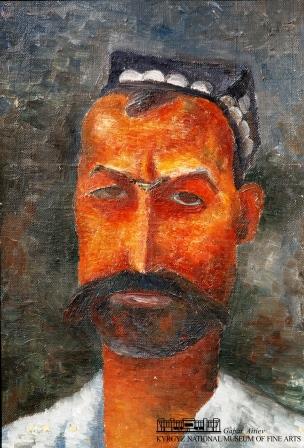 Uzbek head. Canvas, cardboard, oil, 49.3×34.8, 1974
Uzbek head. Canvas, cardboard, oil, 49.3×34.8, 1974
Bearded peasant in a skullcap. A heavy look from under fused eyebrows, gray lips and a frightening mustache. Most likely, this is a sketch of a movie character. Mabe more specifically? From what project? Interest Ask…. It is known that Satar Aitiev worked as an artist on two films. These are Hamlet of the Shchigrovsky District (1975, director Valery Rubinchik); and “Composition” (1970, directed by Igor Kolovsky). But in these Russian projects, characters similar to an Uzbek farmer were not even supposed. There were sketches for an unrealized film based on the novel by Kubatbek Dzhusubaliev “The sun did not finish its self-portrait.” However this portrait is clearly not from there: a different theme and a completely different style. Perhaps this is an unapproved sketch? Unused by the director? Then, this sketch could have been made for the project “The Seventh Bullet” in 1972, directed by Ali Khamraev. The film’s artist was Vadim Dobrin, although Satar Aitiev could well have been the artist. A whole team from Kyrgyzstan worked on the film masterpiece, filmed at the sister film studio Uzbekfilm: Suimenkul Chokmorov! Talgat Nigmatulin! Bolot Beishenaliev! … Perhaps the artist did not work well with the director? Did the concepts match? In an artistic environment, this is normal. Research is useless: if you ask, they will not answer. One thing is clear: there were attempts to work according to the profession, but the attempts were not serious. The artist then already understood that his element was easel painting. But this work cannot be considered easel! Otherwise, they would suspect the author to be xenophobiс! The cinema artist in the USSR could safely answer any tricky questions that this is a “portrait of a Basmach”. Everything would become clear and understandable to everyone.
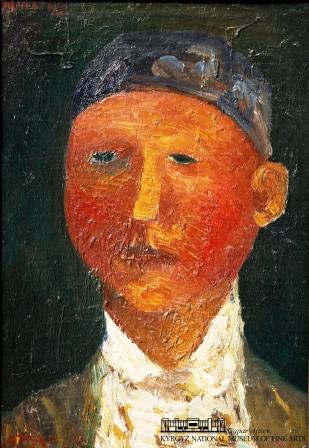 Boy. Canvas, cardboard, oil. 50.4х55.5, 1975
Boy. Canvas, cardboard, oil. 50.4х55.5, 1975
“Boy with a fish” by Semyon Afanasyevich Chuikov immediately comes to mind. His 1929 painting is in the State Tretyakov Gallery. This is the highest level of Orientalism in the style of “Bubnovy valet” (“Jack of Diamonds”)*. In the 70s, the author knows more about his character, he can bring him closer and stop at a fragment. Protruding ears, slits instead of eyes, thin lips and a sloping chin. Not a cutie. A white shirt with a rolled-up collar, a dark skullcap and a robe. Terrible, asymmetrical eyes, a technique often used by Picasso, legitimizes the theme of the ugly in art. Ugliness as part of life is wonderful! And the paint that molds life is also beautiful. As if the flaming face is the properties of color to tan in the sun… The modern artist turned to the achievements of the primitivist period in the fine arts of Kyrgyzstan. To the paintings of the 30s about the tragedy of the uprising of 1616. For what? Now this is not clear. Moreover I really wanted to protest against “the honor, mind and conscience of our era”, there was a strong desire to quarrel and show that everything the characters of the times of lies are freaks. Immediately hide behind another topic so that there are no problems at work. However it didn’t work out to use bird language – it turned out to be a joke. The work was not taken seriously then, and is not taken seriously now.
*BUBNOVY VALET – Association of early avant-garde artists, which existed from 1911 to 1917. For those who want to know more about it (in Russian): БУБНОВЫЙ ВАЛЕТ
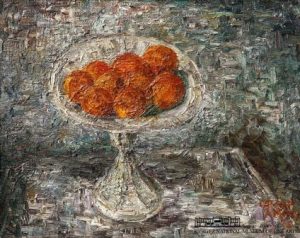 Vase and fruits. 43.7х53.8, 1975
Vase and fruits. 43.7х53.8, 1975
The author has already used this theme. Another attempt to break through the appearance to the idea. Conceptually orange fruit – the rest is grayscale. White-gray tablecloth and on it, in the same shades, a vase. Here and there blue, green specks break through. The stroke of the palette knife becomes the basic element of the structure, like the “black square” in its time. In the melting pot the ideal finds itself and objects wake up. On one’s own! Where is the artist? Painting has nothing to do with it! The author revived the “will” with his talent, was frightened by the “faculty of unnecessary things”, and brightly, largely signed, fixed the order. To make it clear, once and for all, who is in charge here. The artist did not always sign, and if he did, the signature was inconspicuous and small. This time he was delighted and signed: “Ah yes Satar, ah yes son of a bitch” … This is modernism and the axis is not in the center, it has moved to the left. Lined up along the axis: an oval vase, an oval bowl and an oval shadow from the bowl. From the edge the artist drew a corner! The corner of the table sticks out, as in cubism. The artist draws both “ovals” and “corners”. He argues with the poetic geniuses of the Russian avant-garde. Here are the postmodern tendencies. The author cannot do without citations. It cannot do without references to masterpieces, pictorial and poetic. Do you have your own? A vase, orange fruits, a local color – all this has already happened. A feeling of picturesque loneliness? Provincial feel? No originality? Feeling creative freedom! – The right to revive someone else through yourself!
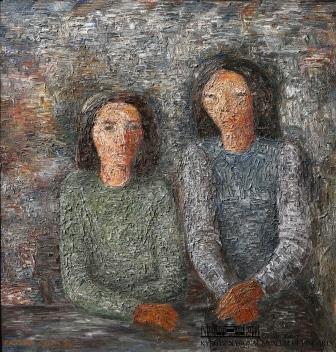 About two sisters. Oil on canvas, 78.7×76.5, 1974
About two sisters. Oil on canvas, 78.7×76.5, 1974
Two sisters are sitting near the table. One is wearing a green jumper, the other is blue. The older one (you can see it all over) has her hands folded on her knees. She is more serious, she is action and activity. The younger one leaned her hands on the table, she looks sad and thoughtful, she dreams. They do not look alike at all, but they have the same hair and clothes. The strokes move along the form, they are also the same … and different, about the concrete and about the universe. The plane of the table is the earth, the walls are clouds, the figures rise like monuments, like two mountains…. The most famous sisters are Chekhov’s Lida and Zhenya. Strong and cruel – weak and kind. After 78 years, new sisters in “new forms” were to appear. They appeared in Soviet Kyrgyzstan, in the painting of national modernism. What is their novelty? In rigidity. In minimalism, which is not similar to conciseness. Laconism is grace, like in Chekhov, when there is nothing superfluous. Here is nothing at all. Nothing even hangs on the walls. There is poverty and hopelessness. The sisters have nowhere to go in this primitive, utilitarian environment. The soul is there, but it has nowhere to aspire. This uncomfortable world appeared as a reaction to the official blissful pictures of the era of stagnation. He was closer to reality… In reality, the sisters will move to other places, or … stay here forever and there will be no continuation… Almighty words are powerless. What we managed to depict in painting, no one has described in our literature.

Poets. 141х155, 1973
Art critic Olga Popova writes about this work as follows: “In … a group portrait “Poets. Dedication “… the artist conveys the psychological depth of the images through a complexly painted painting, the self-immersion of the depicted people into the world of their thoughts, carefully preserving their secret.” The museum called the picture simply “Poets”, without dedication…. Four poets stand in an abstract space. You can see the sky and clouds. One folded his arms on his chest, the other with a notebook, the third holds a faceted glass in his hand. Dedication to the memory of departed poets? These are the ones who will forever remain Poets of the forties. “Forties, fatal …”. Three of the four are easily recognizable – Joomart Bokonbaev (1910-1944), Alykul Osmonov (1915-1950), Midin Alybaev (1917-1959). It is logical to assume that the fourth poet, he stands below with a glass in his hand, is Jusup Turusbekov (1910-1944). Died in the war… However, I’m not sure. There are many poets and it is difficult to make a choice, it is difficult to explain your choice. They can be accused of subjectivity… The artist did not rank the poets, he made his own vision. This is a subjective image and, of course, the author’s vision… This is the most scandalous picture of the artist. They say, there were serious battles around it. Those in power did not want to show it. What were the claims? Without guessing, one can determine – Poets, Batyrs, National pride, are not depicted as they should. The author took a bold step. He proclaimed the principles of an informal portrait! Now forgotten, unfortunately. A genius has created his own world, a world of his own interpretations, formal signs and ideology, different from the generally recognized one. Without the usual pathos. His characters are not broad-shouldered, slender, and clear-eyed. His characters are pathetically miserable. Divine the poor bear their secret.
In “Poets”, S. Aitiev tries to reproduce the images of prominent writers of Kyrgyzstan. The artist’s wrong attitude led to the depersonalization, standardization of the characters of the depicted poets, giving a misleading idea of the deeply agitated lyrics of A. Osmonov, the emotional poetry of J. Bokonbaev, the epic-historical style of M. Elebaev and the high civic pathos of the work of J. Turusbekov, T. Umetaliev
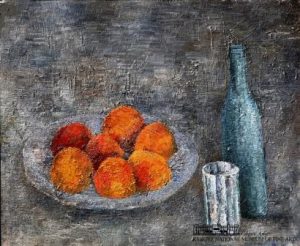 Still life. Apricots. Oil on cardboard, 49.5×59.3, 1973
Still life. Apricots. Oil on cardboard, 49.5×59.3, 1973
Art historian Olga Popova writes about the artist’s works as follows: “… in all the works of Satar Aitiev, the environment has turned into an exquisite play of painterly strokes, creating a moiré unsteadiness of the depicted environment. His conditional space is always alive, full of trepidation and depth, evokes musical associations, unformed in any specific images, but disturbing and exciting with an elusive uncertainty.”
Orange apricots piled up on a plate. Everything else is in shades of gray. Gray plate, gray-green bottle, gray-white glass. In this environment, orange becomes even more orange. There are no habitual reflexes – this is conceptual! The space is depicted! He has a texture – this is the texture of reinforced concrete. This is the life of a modern urban dweller, his idea of objects and their essence. Feels like it seems to him that all objects and even fruits appear from reinforced concrete. The artist works with a palette knife*, like a spatula, plastering the canvas wall. Rough inept plaster turns into a brutal designer refinement. You remember the extraordinarily beautiful still lifes of Giorgio Morandi. There is the texture of Italy… And we have Frunze reinforced concrete, Frunze microdistricts. Frunze of great style: color is a symbol; texture is also a symbol; composition is always a concept; authenticity is great!
*Palette knife is a tool used by artists to mix thick oil paints, clean the palette and apply paint to the canvas. This is a thin elastic plate in the form of a spatula with a handle. With it, you can create complex textures on canvas or apply paint in an even layer over a large area.
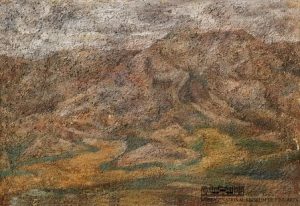 Gray day. Plywood, oil, 70.5×99.5, 1968
Gray day. Plywood, oil, 70.5×99.5, 1968
The work of a student of the Art Department of the Institute of Cinematography (VGIK, Moscow). However this is not student work. The mountain landscape looks more like a whimsical interweaving of abstract patterns. There are no template effects and vulgar contrasts. The composition is defiantly simple, the space is intentionally flat, the coloring is deliberately faded. There is an accentuated desire to break away from visibility and break into the metaphysics of the Kyrgyz landscape! To achieve a greater effect, the artist uses the “impasto” technique, applies paint thickly, uses additives that give texture to the painting. The artist strives to achieve materiality, to physically feel the substance of mountains, hills, sky, clouds. He does not do it very well… Such painting could meet with condemnation from teachers and even accusations of mediocrity. The goals of a talented artist are too high, and the work remains a metaphysical mystery for confused brains. There is no clarity, no simple solutions, no evidence of a clear idea. Impasto* has been mastered, but for the emergence of a new form, new compositional solutions, new meanings are needed. The artist will find new impulses in Kubatbek Dzhusubaliev’s story “The sun has not finished its self-portrait”.
*Impasto is a technique used in painting where paint is applied to an area of a surface in very thick layers, usually thick enough to show the strokes of a brush or paint knife.
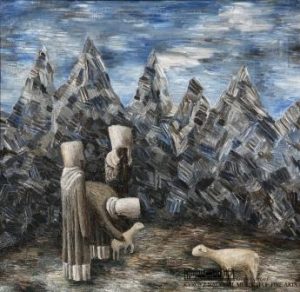 Renaissance. Oil on canvas, 95×98, 1972
Renaissance. Oil on canvas, 95×98, 1972
In a gorge between mountain ranges, three women are examining a newly born lamb. The coloring of the picture is gloomy. Cold blows from the cloudy sky with blue clearings and icy gray-blue mountains. They seem warm: dark figures in white elecheks and the ground covered with snow. The white sheep and the white lamb seem to radiate warmth. Large strokes imitate rocks. The sky, earth, figures have their own texture. Smoothly written pets. The mountains are like toys, like a scenery on a theater stage. The composition is conditional. This is not a real story of cattle-breeding everyday life – this is a symbol! The birth of a lamb is a symbol of rebirth! The birth of a new life, in the midst of a cold and hungry winter. This is a feat of mothers and wives in the difficult years of war hard times… Why is everyone’s face black? No socialist realist confidence in victory? No reason to be happy? Are they surprised that this is still possible? Moreover why does the scene take place in the harsh conditions of the highlands? And here another interpretation is possible… In the 70-80s of the last century, the tragedy of 1616 was reflected in the painting of Kyrgyzstan. You can speak about a forbidden topic, but only allegorically, hinting at details… Then everything becomes clear. This is the exodus, on the way to China. In addition in the blackened faces the tragedy of the people. Those who have lost everything take the lamb from the sheep. Nevertheless this is not a renaissance! Both the lamb of God and the trinity have nothing to do with it. This is our mythology! This Renaissance scene of the human in exile! When everything collapses, the love of life remains! What remains is humanity!
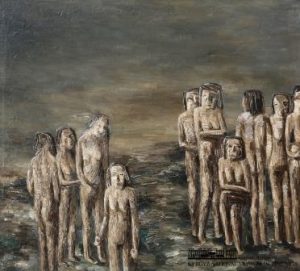 Dedication. Oil on canvas, 90×100, 1972
Dedication. Oil on canvas, 90×100, 1972
The picturesque picture is similar to one-color grisaille*. But the eye always distinguishes between warm and cold shades. Distinguishes texture: smooth – for the sky and prickly – for the earth. Earth is horizontal strokes, figures are vertical. Nude female figures. Poses seen in famous photographs are guessed. One woman sits with her legs crossed. The other holds a child in her arms, her image goes beyond the picture. It’s hard to look at it… Many are drawn without feet. Covered in dirt? They are waiting for something. Waiting for death?.. Done in a general way: it is impossible to determine where and when this happens. Is this a metaphysical initiation? Maybe in the expectation that each era will see its own here? Maybe he will turn away and do not want to see anything … In Soviet times, this work was most likely interpreted as a dedication to women, victims of fascist concentration camps. However this could be directly indicated: in the title or hinted at in details. Barbed wire would be enough. The author does not specify anything. A tribute to the victims of the Holocaust? This topic was hushed up in those days… Perhaps, the author made a dedication to all women who lost their husbands during the Great Patriotic War? A dedication to all brides who have not waited for their betrothed? Alternatively, to everyone in general! For all time? However this is impossible! Impossible in one picture. And what about a woman who, at such a moment, crossed her legs – this one detail determines: the era, style, confrontation… Satar Aitiev directly introduces the aesthetic categories of ugly, distorted, deformed into the fine arts of Kyrgyzstan. For what? Moreover then, to show that after such atrocities, it is impossible to enjoy the sun, to love, to forgive stupidity and betrayal. Live as if nothing had happened and study the history of art… Sorry for the irony, I accidentally escaped… why not! The artist cannot live with this and vomits his despair on the canvas. However, humanity as a whole … may turn away and will not want to see anything…
*Grisaille is a painting executed entirely in shades of grey or of another neutral greyish colour.
 Portrait of a young Kyrgyz. Oil on canvas, 48×45, 1971
Portrait of a young Kyrgyz. Oil on canvas, 48×45, 1971
Dark green background, dark shirt, black hair. They only slightly differ in tone and shade. The conditional space is marked with a brutal texture. Formally, this is a portrait of a young Kyrgyz, handsome, slender, working or intellectual. In addition, of course, he is concerned about the most pressing problems of our time. It seems that this is a modernized image of the builder of the material base of communism. He is stern, it was fashionable in the 70s, devoid of sentiment and vulgar pathos, calmly doing his job without further ado. Period. However, if you look closely, it becomes clear that the artist painted a portrait about something completely different. A copper face, an unhealthy blush, dark slits in the eye sockets, the eyes are not visible, they are not needed. Flickering in the dark mysterious glare. This is the mask of a city dweller, which develops into the essence. This is about the lack of spirituality of the city and the terrible attractiveness of this lack of spirituality. The mask wants to scare and amaze. It warns about something. About a dangerous split personality? Here is Kyrgyz Freudianism, decadence and thriller. Total misunderstanding turns a wonderful work of art into a failed experiment. In order to appreciate such works, one must understand the subconscious of the Fine Arts of the Republic!
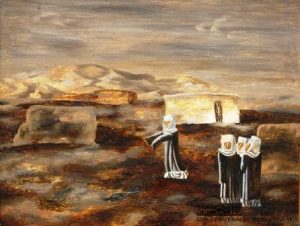 Sketch for the film “The Sun did not finish its self-portrait.” Oil on cardboard, 52.4×60, 1970
Sketch for the film “The Sun did not finish its self-portrait.” Oil on cardboard, 52.4×60, 1970
Art critic Olga Popova writes about the artistic method of Satar Aitiev, who received the specialty of a film production designer at VGIK: “… at the beginning of his creative path, he still relied on the experience of filmmakers, creating sketches for an unrealized film based on Kubatbek Dzhusubaliev’s story “The Sun did not finish its self-portrait.” They already showed the psychologism of pictorial conventionality, love for pure picturesqueness, fine organization of color composition.
Conditional background – earth, cloudy sky and distant mountains are visible, or disappeared behind the fog. Lonely yurt or adobe huts. Conditional female figures in elecheks. One conditionally throws up her hands. Sketches form the plasticity of the future film, the times of war hard times. There is a theatrical convention. Both the story itself and the sketches for the film are not at all Soviet in mood. In the era of developed socialism in the USSR, ambiguous tragic works appeared, rigidly made in form. However, they always appealed to the light, to “optimistic tragedy.” In the case under consideration, there is no gap, and this allows us to attribute both the story and the sketches to “Soviet modernism”. In the era of developed socialism, the story was met with indignation, it was accused of speculating on the unsightly sides of Soviet reality (they still blame it, from a slightly different position). The film was not finished, the line of development was interrupted, and both literature and cinema remained not-before-modernized, but in the painting of Kyrgyzstan, the process of major modernization flourished.
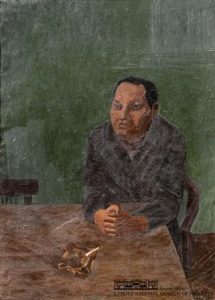 Portrait of contemporary. 1971. Oil on canvas, 128×92
Portrait of contemporary. 1971. Oil on canvas, 128×92
In my opinion, Kyrgyz modernism begins with this portrait. Then it was not called that, and perhaps it was not realized, but all the signs of a new phenomenon are evident. One cannot call it socialist realism. It is not about the form, it’s about the mood. The level of skepticism is on the rise. For the first time, the concept of “ugly” is being affirmed as an aesthetic category. Perhaps, out of a desire to be cooler, to assert itself in front of a glorious past, to make a breakthrough into an immense future … It doesn’t matter. A modernist principle appeared: there is no admiration, no optimism, no desire to please the party, the government, the people … A man is sitting at the table. Almost on the corner. Bad luck, but he does not care. He folded his hands in front of an ashtray and one cigarette. One, next to an empty chair. Wearing a thick dark brown pullover, dark green surroundings, dark furnishings. Deliberately simplified monochromatic range of dark colors: green, brown, black. Flat shape, texture hints at volume without picturesque prettiness. Detailed ashtray. Paradoxically… Is an ashtray a compass, a watch, a tape measure? … A game! Game of meanings! Formal devices are meaningful, they portray a dull skeptic, a young cynic, our contemporary! A hero of our time, who is like a bitter medicine. Original, original and no romance! Connoisseurs were horrified, but exhibited in the museum, because the father’s merits are undeniable. Major Kyrgyz modernism has begun! Modernism from the majors – the children of the patriarchs! … This is both a symbol and a sign, and a living person. He involuntarily poses. The artist intuitively guessed the main thing – the model is pretty with her pose. The one who was able to understand this phenomenon in time realized this pose as a position in art. This is risky – a little more, and such a game of seriousness will become a far-fetched, uninteresting demeanor.
<= ISSUE 9 TO BE CONTINUED
Telegram-channel in Kyrgyz & Russian:
Санжарбек Данияровдун коомдук фонду
Фонд Санжарбека Даниярова
Subscribe if interested




